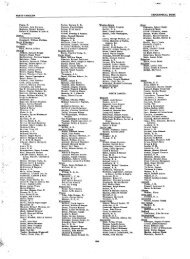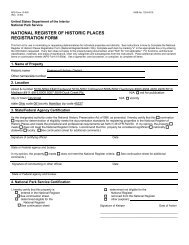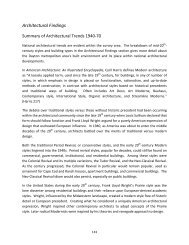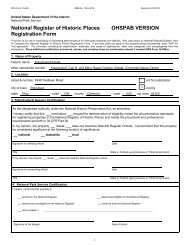National Register of Historic Places Registration Form
National Register of Historic Places Registration Form
National Register of Historic Places Registration Form
You also want an ePaper? Increase the reach of your titles
YUMPU automatically turns print PDFs into web optimized ePapers that Google loves.
Southington Local School District Campus<br />
Name <strong>of</strong> Property<br />
Trumbull County<br />
Ohio<br />
County and State<br />
complete with dentils and modillions, which are topped with a gable ro<strong>of</strong> projecting from the main hipped ro<strong>of</strong><br />
block. Supporting the pediment are four fluted Greek Ionic columns, resting on bases atop the concrete porch<br />
deck. The front entrance is framed by a shouldered stone surround with keystone. Symmetric, rectangular<br />
windows feature contrasting brick panels and keystone on the first story with contrasting brick detailing that<br />
matches quoins on the second story. In addition, presence <strong>of</strong> the arched stained glass window further associates<br />
this building with the Neo-Classical style. The porte-cochere exhibits matching, but smaller scale triple<br />
columns with a ro<strong>of</strong>-line balustrade. To further enhance the dignity <strong>of</strong> this public building, Chalker<br />
commissioned matching stone lions to flank the main entrance stairs. Interestingly, a death notice published in<br />
the Akron Beacon Journal on April 21, 1921 noted that Chalker also “furnished the design for two large stone<br />
lions that adorn the entrance to the courthouse.” 13 The Summit County Courthouse, completed in 1908, was<br />
under construction at roughly the same time as Southington’s high school. Although the lions in Summit<br />
County appear to be slightly more stylized, they do bear a strong resemblance to Southington’s.<br />
The dedication <strong>of</strong> the Chalker Building on August 22, 1907 was attended by several thousand people; a<br />
significant gathering, considering the 1900 census listed the population <strong>of</strong> the township at only 750 residents.<br />
The event was chronicled on the front page <strong>of</strong> the Warren Daily Tribune who categorized it as marking “an<br />
epoch in the educational history <strong>of</strong> the town,” and described the structure as “one <strong>of</strong> the finest buildings in<br />
Trumbull County.” 14 In addition, Youngstown industrialist and author, Joseph G. Butler, in his History <strong>of</strong><br />
Youngstown and the Mahoning Valley, Ohio, published in 1921, also called the Chalker Building “one <strong>of</strong> the<br />
finest rural high school structures in Ohio.” 15<br />
In addition to providing an impressive and modern high school, Chalker also envisioned his contribution to<br />
include cultural enrichment for this small community. He personally stocked the library with a rich assortment<br />
<strong>of</strong> books. Throughout the Chalker Building are large ornately framed oil paintings that depict photographs taken<br />
by Chalker <strong>of</strong> architectural landmarks from his European and Middle Eastern travels.<br />
Typical <strong>of</strong> many small, rural communities, the school campus also served as primary social and civic center for<br />
the residents. Terms <strong>of</strong> the deed signed by Chalker on August 17, 1907 which transferred ownership <strong>of</strong> the<br />
property and high school to Southington’s Board <strong>of</strong> Education stipulates that the Board “shall not permit said<br />
Auditorium to be used otherwise than for literary society entertainments, lectures, concerts, graduation and<br />
other educational purposes and refined social entertainment.” The stature <strong>of</strong> the landmark building, coupled<br />
with the fact that it was the only public structure within the community that was capable <strong>of</strong> holding several<br />
hundred people assured its use on holidays, for entertainment, and as a gathering place for special events.<br />
The celebration held early in November, 1921 as the community gathered at the school to celebrate the arrival<br />
<strong>of</strong> electricity to the township typified these community attended events. According to a newspaper article in the<br />
Warren Daily Tribune on November 2 nd , the crowd <strong>of</strong> several hundred people gathered on campus to witness<br />
the illuminating <strong>of</strong> strings <strong>of</strong> electric lights strung around the top <strong>of</strong> the Chalker Building and around the<br />
soldier’s monument. Following the big event, a cake walk was held in the auditorium and a display <strong>of</strong> electrical<br />
appliances was presented in the basement <strong>of</strong> the Chalker Building, with fund raisers held to help defray the cost<br />
<strong>of</strong> electrifying the building. 16<br />
Chalker retained an active interest in the development <strong>of</strong> the high school, even after he signed the deed over to<br />
Southington’s Board <strong>of</strong> Education. Additional conditions outlined in the deed included that the land conveyed<br />
13 Attorneys Pay Tribute To Newton Chalker, Akron Beacon Journal, (evening ed.), 21 April 1921, p. 1.<br />
14 Chalker High School Dedicated, Warren Daily Tribune, 29 August 1907, p. 1<br />
15 . Joseph Green Butler, History <strong>of</strong> Youngstown and Mahoning Valley, Ohio (American <strong>Historic</strong>al Society. 1921), p. 631.<br />
16 All lit Up, Southington Celebrates the Turning on <strong>of</strong> Electric Lights There, Warren Daily Tribune, 2 November 1921. p. 1.<br />
14






